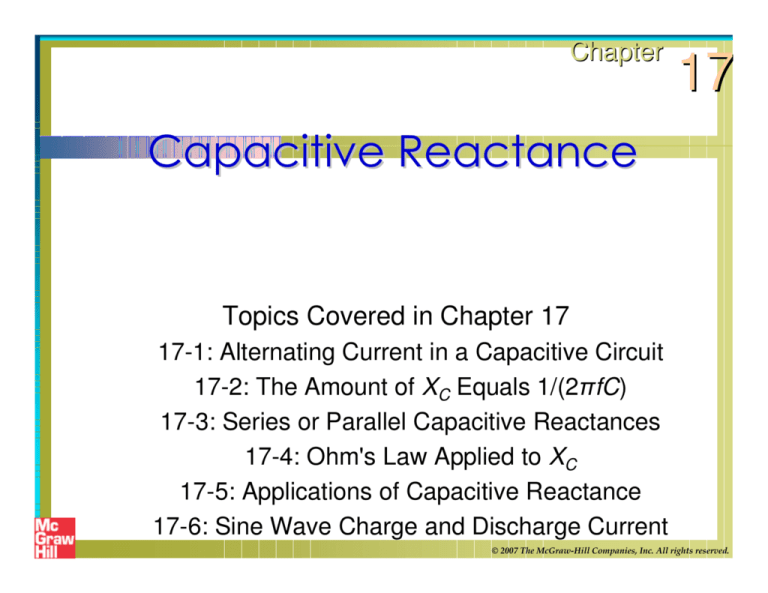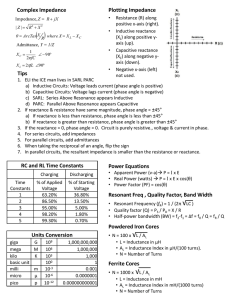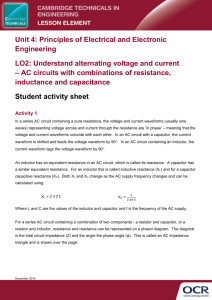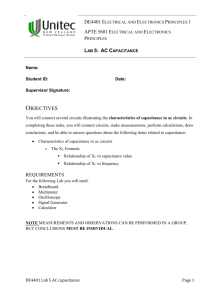
Chapter
17
Capacitive Reactance
Topics Covered in Chapter 17
17-1: Alternating Current in a Capacitive Circuit
17-2: The Amount of XC Equals 1/(2πfC)
17-3: Series or Parallel Capacitive Reactances
17-4: Ohm's Law Applied to XC
17-5: Applications of Capacitive Reactance
17-6: Sine Wave Charge and Discharge Current
© 2007 The McGraw-Hill Companies, Inc. All rights reserved.
17-1: Alternating Current in a
Capacitive Circuit
Capacitive reactance is the opposition a capacitor
offers to the flow of sinusoidal current.
Symbol: XC
Units: Ohms
Formula (this applies only to sine wave circuits):
1
XC =
2π f C
McGraw-Hill
© 2007 The McGraw-Hill Companies, Inc. All rights reserved.
17-1: Alternating Current in a
Capacitive Circuit
Current flows with ac voltage applied to a series
connected capacitor and light bulb.
There is NO current through the capacitor’s dielectric.
While the capacitor is being charged by increasing
applied voltage, the charging current flows in one
direction in the conductors to the plates.
While the capacitor is discharging, when the applied
voltage decreases, the discharge current flows in the
reverse direction.
With alternating voltage applied, the capacitor
alternately charges and discharges.
17-1: Alternating Current in a
Capacitive Circuit
With a 4-µF capacitor,
the bulb lights brightly.
The smaller capacitor has
more opposition to ac and
the bulb is dim.
The capacitor blocks
dc and the bulb
cannot light.
Fig. 17-1: Current in a capacitive circuit. (a) The 4-µF capacitor allows enough current I to
light the bulb brightly. (b) Less current with smaller capacitor causes dim light. (c) Bulb cannot
light with dc voltage applied because a capacitor blocks the direct current.
Copyright © The McGraw-Hill Companies, Inc. Permission required for reproduction or display.
17-1: Alternating Current in a
Capacitive Circuit
Summary:
Alternating current flows in a capacitive circuit with ac
voltage applied.
A smaller capacitance allows less current, which means
more XC with more ohms of opposition.
Lower frequencies for the applied voltage result in less
current and more XC.
With a steady dc voltage source (zero frequency),
the capacitor’s opposition is infinite and there is no
current. In this case the capacitor is effectively an
open circuit.
17-1: Alternating Current in a
Capacitive Circuit
Summary, cont.
XC depends on the frequency of the applied voltage and
the amount of capacitance.
XC is less for more capacitance.
XC is less for higher frequencies.
17-2: The Amount of XC
Equals 1/(2π f C)
Factors Affecting XC
The value of XC is inversely proportional to the value of
capacitance:
Increasing C decreases XC
Decreasing C increases XC
The value of XC is inversely proportional to the
frequency:
Increasing f decreases XC
Decreasing f increases XC
17-2: The Amount of XC
Equals 1/(2π f C)
Summary of the XC Formulas:
When f and C are known:
When XC and f are known:
When XC and C are known:
1
XC =
2π f C
1
C=
2π f XC
1
f =
2π C XC
17-3: Series or Parallel
Capacitive Reactances
Capacitive reactance is an opposition to AC, so series
or parallel reactances are combined in the same way as
resistances.
Combining capacitive reactances is opposite to the way
capacitances are combined. The two procedures are
compatible because of the inverse relationship between
XC and C.
17-3: Series or Parallel
Capacitive Reactances
Series Capacitive Reactance:
Total reactance is the sum of the individual reactances.
XCT = XC1 + XC2 + XC3 + ... + etc.
All reactances have the same current.
The voltage across each reactance equals current times
reactance.
VC1 = I × XC1
17-3: Series or Parallel
Capacitive Reactances
Parallel Capacitive Reactances
Total reactance is found by the reciprocal formula:
1
XCT
=
1
XC1
+
1
XC2
+
1
XC3
+ ... + etc.
All reactances have the same voltage.
The current through each reactance equals voltage
divided by reactance.
I C = VC / X C
17-4: Ohm's Law Applied to XC
Current in an ac circuit with XC alone is equal to the applied
voltage divided by the ohms of XC.
I = V/XC = 1 A
I = V/XCT = 1/3 A
IT = I1 + I2 = 1 ½ A
Fig. 17-6: Example of circuit calculations with XC. (a) With a single XC, the I = V/XC. (b) Sum of
series voltage drops equals the applied voltage VT. (c) Sum of parallel branch currents equals
total line current IT.
Copyright © The McGraw-Hill Companies, Inc. Permission required for reproduction or display.
17-5: Applications of
Capacitive Reactance
The general use of XC is to block direct current but
provide low reactance for alternating current.
Ohms of R remain the same for dc or ac circuits, but XC
depends on frequency.
The required C becomes smaller for higher frequencies.
17-5: Applications of
Capacitive Reactance
Table 17-1
C (Approx.)
Capacitance Values for a Reactance of 100 Ω
Frequency
Remarks
27 µF
60 Hz
Power-line and low audio frequency
1.6 µF
1000 Hz
Audio frequency
0.16 µF
10,000 Hz
Audio frequency
1600 pF
1000 kHz (RF)
AM radio
160 pF
10 MHz (HF)
Short-wave radio
16 pF
100 MHz (VHF) FM radio
17-5: Applications of
Capacitive Reactance
Summary of Capacitance vs. Capacitive Reactance:
Capacitance
Symbol is C
Unit is F
Value depends on
construction
iC = C(dv/dt)
Capacitive Reactance
Symbol is XC
Unit is Ω
Value depends on C and f
XC = vc / ic or 1/(2πfC)
17-5: Applications of
Capacitive Reactance
Summary of Capacitive Reactance vs. Resistance:
Capacitive Reactance
Symbol is XC
Unit is Ω
Value decreases for
higher f
Current leads voltage by
90°(Θ = 90°).
Resistance
Symbol is R
Unit is Ω
Value does not change
with f
Current and voltage are in
phase (Θ = 0°).
17-6: Sine Wave Charge and
Discharge Current
VA is positive and
increasing,
charging C.
VC decreases
by discharging.
VA increases but
in the negative
direction. C
charges but in
reverse polarity.
Negative VA
decreases and
C discharges.
Fig. 17-7: Capacitive charge and discharge currents. (a) Voltage VA increases positive to charge
C. (b) The C discharges as VA decreases. (c) Voltage VA increases negative to charge C in
opposite polarity. (d) The C discharges as reversed VA decreases.
Copyright © The McGraw-Hill Companies, Inc. Permission required for reproduction or display.
17-6: Sine Wave Charge and
Discharge Current
Charge and discharge current of a capacitor can be
found if we know two factors:
1. The capacitance value of the capacitor
2. The rate of voltage change across the capacitor
Capacitive current, iC depends on the rate of voltage
change across its plate
17-6: Sine Wave Charge and
Discharge Current
Calculating the Values of iC.
The greater the voltage change, the greater the amount
of capacitive current.
Capacitive current is calculated
ic = C
dv
dt
i is in amperes
C is in farads
dv/dt = volts per second.
17-6: Sine Wave Charge and
Discharge Current
90°Phase Angle
iC leads vC by 90°.
ICE
The difference results from the fact that iC depends on
the dv/dt rate of change, not v itself.
The ratio of vC / iC specifies the capacitive reactance in
ohms.
17-6: Sine Wave Charge and
Discharge Current
dv/dt for Sinusoidal Voltage is a Cosine Wave
Voltage
dv/dt
dv
i =C
C
dt
0
θ
Sine wave
Vinst. = Vmax x cos θ
Copyright © The McGraw-Hill Companies, Inc. Permission required for reproduction or display.








